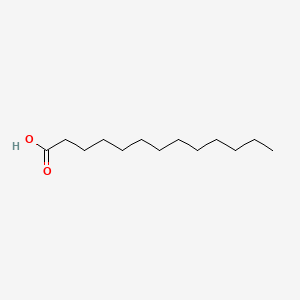| MeSH term | MeSH ID | Detail |
|---|---|---|
| Diabetes Mellitus | D003920 | 90 associated lipids |
TRIDECANOIC ACID
TRIDECANOIC ACID is a lipid of Fatty Acyls (FA) class. Tridecanoic acid is associated with abnormalities such as Fatty Liver, hypoglycemia and Cardiomyopathies. The involved functions are known as Catalyst, Protein Overexpression, Insulin Resistance, Oxidation and Cell Death. Tridecanoic acid often locates in peroxisome, Mitochondria, Protoplasm, Cytosol and Cell membrane. The related lipids are Tridecanoic Acid, Fatty Acids, Fatty Acids, Nonesterified, stearic acid and margaric acid.
Cross Reference
Introduction
To understand associated biological information of TRIDECANOIC ACID, we collected biological information of abnormalities, associated pathways, cellular/molecular locations, biological functions, related genes/proteins, lipids and common seen animal/experimental models with organized paragraphs from literatures.
What diseases are associated with TRIDECANOIC ACID?
TRIDECANOIC ACID is suspected in Fatty Liver, hypoglycemia, Cardiomyopathies and other diseases in descending order of the highest number of associated sentences.
Related references are mostly published in these journals:
| Disease | Cross reference | Weighted score | Related literature |
|---|
Possible diseases from mapped MeSH terms on references
We collected disease MeSH terms mapped to the references associated with TRIDECANOIC ACID
PubChem Associated disorders and diseases
What pathways are associated with TRIDECANOIC ACID
There are no associated biomedical information in the current reference collection.
PubChem Biomolecular Interactions and Pathways
Link to PubChem Biomolecular Interactions and PathwaysWhat cellular locations are associated with TRIDECANOIC ACID?
Visualization in cellular structure
Associated locations are in red color. Not associated locations are in black.
Related references are published most in these journals:
| Location | Cross reference | Weighted score | Related literatures |
|---|
What functions are associated with TRIDECANOIC ACID?
Related references are published most in these journals:
| Function | Cross reference | Weighted score | Related literatures |
|---|
What lipids are associated with TRIDECANOIC ACID?
Related references are published most in these journals:
| Lipid concept | Cross reference | Weighted score | Related literatures |
|---|
What genes are associated with TRIDECANOIC ACID?
There are no associated biomedical information in the current reference collection.
What common seen animal models are associated with TRIDECANOIC ACID?
There are no associated biomedical information in the current reference collection.
NCBI Entrez Crosslinks
All references with TRIDECANOIC ACID
Download all related citations| Authors | Title | Published | Journal | PubMed Link |
|---|---|---|---|---|
| de Camargo AC et al. | Gamma radiation induced oxidation and tocopherols decrease in in-shell, peeled and blanched peanuts. | 2012 | Int J Mol Sci | pmid:22489128 |
| Radakovits R et al. | Draft genome sequence and genetic transformation of the oleaginous alga Nannochloropis gaditana. | 2012 | Nat Commun | pmid:22353717 |
| Zhang J et al. | Esophageal cancer metabolite biomarkers detected by LC-MS and NMR methods. | 2012 | PLoS ONE | pmid:22291914 |
| Li RW et al. | Perturbation dynamics of the rumen microbiota in response to exogenous butyrate. | 2012 | PLoS ONE | pmid:22253719 |
| Duong CT and Roper MG | A microfluidic device for the automated derivatization of free fatty acids to fatty acid methyl esters. | 2012 | Analyst | pmid:22166918 |
| Harada E et al. | Functional evolution of duplicated odorant-binding protein genes, Obp57d and Obp57e, in Drosophila. | 2012 | PLoS ONE | pmid:22238638 |
| Li Y et al. | Modulation of lipid digestibility using structured emulsion-based delivery systems: comparison of in vivo and in vitro measurements. | 2012 | Food Funct | pmid:22344205 |
| Schneider AC et al. | Conversion of t11t13 CLA into c9t11 CLA in Caco-2 cells and inhibition by sterculic oil. | 2012 | PLoS ONE | pmid:22427892 |
| Yan H et al. | Molecular dynamics study of the effect of calcium ions on the monolayer of SDC and SDSn surfactants at the vapor/liquid interface. | 2011 | Langmuir | pmid:21495650 |
| Klenk HP et al. | Complete genome sequence of the thermophilic, hydrogen-oxidizing Bacillus tusciae type strain (T2) and reclassification in the new genus, Kyrpidia gen. nov. as Kyrpidia tusciae comb. nov. and emendation of the family Alicyclobacillaceae da Costa and Rainey, 2010. | 2011 | Stand Genomic Sci | pmid:22180816 |
